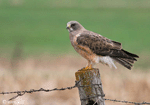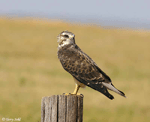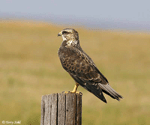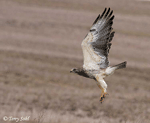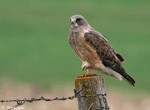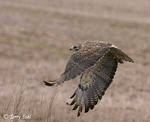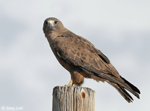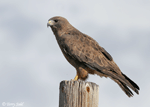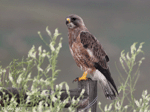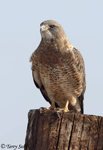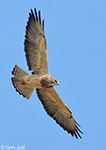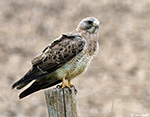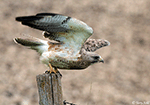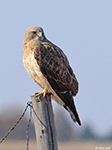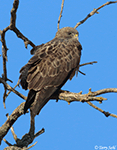| Length: 19 - 22 inches | Wingspan: 46 - 54 inches | Seasonality: Summer / Migrant |
| ID Keys: White wing linings contrasting with dark flight feathers. Otherwise quite variable, depending upon color phase | ||
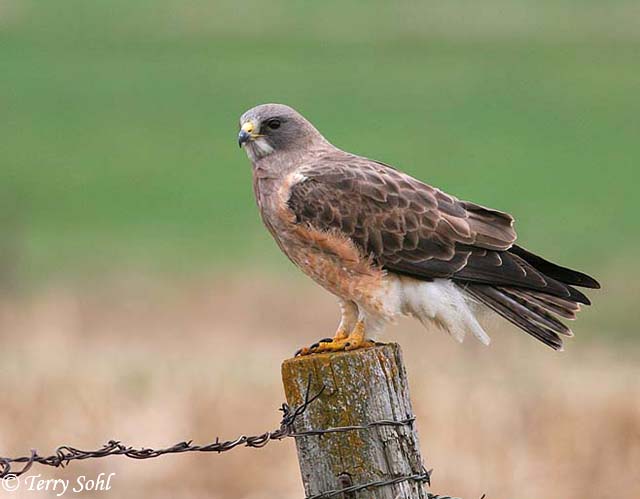 A very long-distance
migrant, Swainson's Hawks winter as far south as the southern tip of South America.
They often congregate in flocks numbering in the thousands as they move
southward in the Fall. They are more
common in the western part of the state, due to their preference for prairie land
with scattered trees. They aren't as common in areas that are predominantly
farmland. Swainson's Hawks have three different color morphs: light,
rufous, and dark. An intermediate (rufous) morph is shown in the photo on the right.
Additional photos, including those of different color morphs, can be found at
the bottom of the page.
A very long-distance
migrant, Swainson's Hawks winter as far south as the southern tip of South America.
They often congregate in flocks numbering in the thousands as they move
southward in the Fall. They are more
common in the western part of the state, due to their preference for prairie land
with scattered trees. They aren't as common in areas that are predominantly
farmland. Swainson's Hawks have three different color morphs: light,
rufous, and dark. An intermediate (rufous) morph is shown in the photo on the right.
Additional photos, including those of different color morphs, can be found at
the bottom of the page.
Habitat:
Plains, dry grassland, farmland, ranch country
Diet:
Despite it's large size, most often feeds on large insects. Also small mammals, reptiles, and birds.
Behavior:
Despite its relatively large size, Swainson's Hawks are very good at catching insects in mid-air. They also will walk along the ground to forage for insects. Other hunting strategies include perching and watching for prey, or slowly soaring over open lands.
Nesting:
May through July in South Dakota. The nest of a Swainson's Hawk is a large platform constructed of branches and twigs, sometimes including other material, including man-made materials. The center of the nest is a shallow bowl lined with twigs, grasses, herbaceous vegetation, and other softer materials. The nest is typically placed in a small grove of trees, near the top of a tree, although in parts of their range where tall trees are rare, they will nest in small trees or shrubs much closer to the ground. The nest is constructed by both the male and female, and the pair also share incubation duties. The female lays 2-5 eggs, which hatch after about 30 days. The young fledge from the nest about 4 weeks after hatching.
Song:
The primary vocalization that's heard is a piercing SCREeeeeeeee call, typically declining in volume towards the end. They also have a shorter, piercing shreek call.
- Click here to hear the typical screaming call of a Swainson's Hawk1
- Click here to hear the short flight call of a Swainson's Hawk2
Migration:
Summers throughout much of the central and western United States and Canada. Primarily winters in southern South America.
Interactive eBird map:
Click here to access an interactive eBird map of Swainson's Hawk sightings
Similar Species:
Depending on morph and age, can appear similar to Red-Tailed Hawk, Rough-legged Hawk, or Broad-winged Hawk. Click here for a page that describes differences between the "Buteo" hawk species, and identification keys for each.
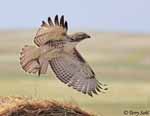 |
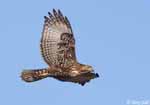 |
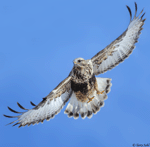 |
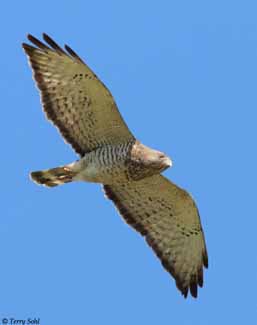 |
| Red-tailed Hawk | Red-tailed Hawk | Rough-legged Hawk | Broad-winged Hawk |
Conservation Status:
Has generally been declining. Huge numbers of dead Swainson's Hawks have been found in locations in South America. Heavy pesticide use in their wintering grounds kill millions of insects, which concentrations of Swainson's feed on, and thus become poisoned. However, there are still good numbers of Swainson's Hawks, and the IUCN considers the species to be of "Least Concern".
Further Information:
Photo Information:
April 17th, 2006 - Minnehaha County - Terry Sohl
Additional Photos:
Click on the image chips or text links below for additional, higher-resolution Swainson's Hawk photos.
Audio File Credits:
- 1Julia Wittmann. Recorded in Weld County, Colorado on August 5th, 2018. Original recording and information available from xeno-canto.
- 2Gabriel Leite. Recorded near Laramie, Wyoming on May 5th, 2003. Original recording and information available from xeno-canto.
| Click on the range map for a higher-resolution view |
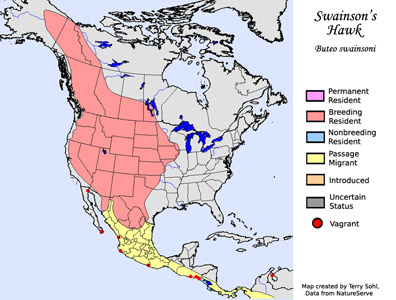 |
| South Dakota Status: Common migrant throughout the state. Common summer resident in the northern and western part of the state, uncommon elsewhere. |
Additional Swainson's Hawk Photos
Click for a higher-resolution version of these photos
